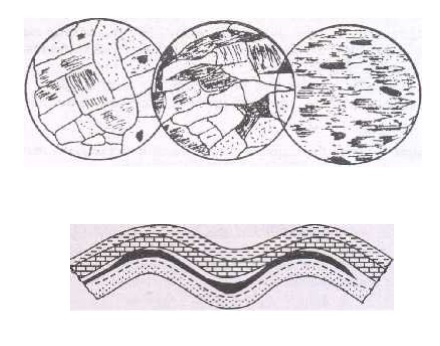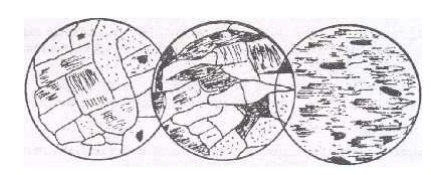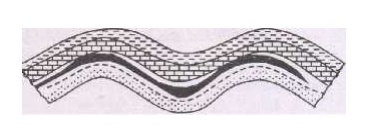Chapter: Civil : Engineering Geology : Petrology
Igneous Rocks

IGNEOUS ROCKS
Ø
Rocks that have formed from an originally hot
molten material through the process of cooling and crystallization may be
defined as igneous rocks.
Important Conditions For The Original Material
Ø
very high temperature and
Ø
a molten state
COMPOSITION
Magma
1 The hot
molten material occurring naturally below the surface of the Earth is called
magma.
2 It is
called lava when erupted through volcanoes.
3 Igneous
rocks are formed both from magma and lava.
4 It maybe
mentioned here that magma is actually a hypothetical melt.
5 Lava is a
thoroughly studied material that has poured out occasionally from volcanoes in
many regions of the world again and again.
6 Magma or
lava from which igneous rocks are formed may not be entirely a pure melt: it
may have a crystalline or solid fraction and also a gaseous fraction thoroughly
mixed with
it.
7 The solid
and gaseous fractions, however, form only a small part of the magma or lava,
which are predominantly made up of liquid material igneous rock.
Igneous rocks are divided into following three sub-groups
Volcanic rocks
Ø
These are the igneous rocks formed on the surface
of the Earth by cooling and crystallisation of lava erupted from volcanoes.
Ø
Since the lava cools down at very fast rate
(compared to magma), the grain size of the crystals formed in these rocks is
very fine, often microscopic.
Further, cooling of lava may take place on the
surface or even under waters of seas and oceans, the latter process being more
common.
Plutonic Rocks
Ø
These are igneous rocks formed at considerable
depths-generally between 7-10 km below the surface of the earth.
Ø
Because of a very slow rate of cooling at these
depths, the rocks resulting from magma are coarse grained.
Ø
These rocks get exposed on the surface of the
earth as a consequence of erosion of the overlying strata.
Ø
Granites, Syenites, and Gabbros are a few examples
of Plutonic rocks.
Hypabyssal Rocks
Ø
These igneous rocks are formed at intermediate
depths, generally up to 2 kms below the surface of the earth and exhibit mixed
characteristics of volcanic and plutonic rocks.
Ø
Porphyries of various compositions are examples
of hypabyssal rocks.
COMPOSITION
Mineralogical composition
Ø Igneous rocks like other rock groups are
characterised by the abundance of only a few, minerals.
S.No Mineral (%) S.No Mineral (%)
(i) Felspars 59.5
(ii) Pyroxenes & Amphiboles 16.8
(iii Quartz 12.0
(iv) Biotite 3.8
(v) Titanium 1.5
(vi) Apatite 0.6
(vii Accessory Minerals 5.8
1. TEXTURES OF IGNEOUS ROCKS
Ø
The term texture is defined as the mutual
relationship of different mineralogical constituents in a rock. It is
determined by the size, shape and arrangement of these constituents within the
body of the rock.
Factors Explaining Texture
The following three factors will primarily define
the type of texture in a given igneous
rock:
Degree of Crystallization
Ø In an
igneous rock, all the constituent minerals may be present in distinctly
crystallized forms and easily recognized by unaided eye, or, they may be poorly
crystallized or be even glassy or non- crystallized form.
Ø
The resulting rock textures are then described as:
(i)
Holocrystalline: When all the constituent
minerals are distinctly crystallized;
(ii) Holohyaline:
When all the constituents are very fine in size and glassy or non
crystalline in nature.
Ø
The term merocrystalline is commonly used
to express the intermediate type, i.e. when some minerals are
crystallized and others are of glassy character in the same rock.
Ø
Rocks with holocrystalline texture are also
termed as phaneric and the holohyaline rocks
are referred as aphinitic. The
term microcrystalline is used for the textures in which the minerals are
perceivably crystallized but in extremely fine grain.
Granularity
Ø
The grain size of the various components of a rock
are the average dimensions of different constituent minerals which are taken
into account to describe the grain size of the rock as a whole. Thus the rock
texture is described as :
(i)
Coarse-grained. When
the average grain size is above 5 mm; the constituent minerals
are then easily identified with naked eye.
(ii)
Medium-grained. When
the average grain size lies between 5 mm and 1 mm. Use of magnifying
lens often becomes necessary for identifying ail the constituent mineral
components.

(iii) Fine-grained. When
the average grain size is less than 1 mm. In such rocks, identification
of the constituent mineral grains is possible only with the help of microscope
for which very thin rock sections have to be prepared for microscopic studies
Fabric
Ø
This is a composite term expressing the relative
grain size of different mineral constituents in a rock as well as the degree of
perfection in the form of the crystals of the individual minerals.
Ø
The texture is termed as equigranular when all the
component minerals are of approximately equal dimensions and as inequigranular
when some minerals in the rock are exceptionally larger or smaller than the
other.
Ø Similarly,
the shape or form of the crystals, which is best seen only in thin sections
under microscope, may be described as perfect, semi perfect or totally
irregular. The textural terms to describe these shapes are, respectively,
euhedral, subhedral and anhedral.
Ø
An igneous rock may contain crystals of anyone
type in a predominating proportion;
hence its fabric will be defined by one of the following three
terms related to fabric:
(i)
Panidiomrphi: when
majority of the components are in fully developed shapes;
(ii)
Hypidiomorphic: the
rock contains crystals of all the categories: euhedral, subhedral or
anhedral;
(iii)
Allotriomorphic: when
most of the crystals are of anhedral or irregular shapes
Types of Textures
These can be broadly divided into five categories:
. Equigranular textures
. Inequigranular textures
. Directive textures
. Intergrowth textures and
. Intergranular textures.
(1)
Equigranular Textures
Ø
All those textures in which majority of
constituent crystals of a rock are broadly equal in size are described as
equigranular textures.
Ø
In igneous rocks, these textures are shown by
granites and felsites and hence are also often named as granitic and felsitic
textures
Ø
In the granitic
texture, the constituents
are either all
coarse grained or all
medium grained and the crystals show euhedral to subhedral
outlines.
Ø
In the felsitic texture, the rock is micro
granular, the grains being mostly microscopic crystals but these invariably
show perfect outlines.
Ø
Thus felsitic textures may be described as
equigranular and panidiomrphic.
Orthophyric texture is another type of
equigranular texture, which is in between
the granitic and felsitic textures.
The individual grains are fine in size but not micregranular.
(2)
Inequigranular Texture
Ø
Igneous textures in which the majority of
constituent minerals show marked difference in their relative grain size are
grouped as inequigranular texture.
Ø
Porphyritic and Poiklitic textures are important
examples of such textures.
Ø
Porphyritic Texture is characterised by the
presence of a few conspicuously large sized crystals
(the phenocrysts) which are
embedded in a fine-grained ground mass or matrix.
Ø
The texture is sometimes further distinguished
into mega-porphyritic and microporphyritic depending upon the size of the
phenocrysts.
Difference in. molecular concentration
Ø When the magma is rich in
molecules of particular mineral, the latter has better chance to grow into big
crystals which may get embedded in the fine-grained mass resulting from the
deficient components.
Change in physico-chemical conditions.
Ø
Every magma is surrounded by a set of
physico-chemical conditions like temperature, pressure and chemical
composition, which influence the trend of crystallisation greatly.
Ø
Abrupt and discontinuous changes in these textures
may result in the formation of the crystals of unequal dimensions.
Ø
Thus, magma crystallizing at great depths may
produce well-defined, large sized crystals.
Ø
When the same magma (carrying with it these large
crystals) moves upward, the pressure and temperature acting on it are greatly
reduced.
Ø
Crystallisation in the upper levels of magma
becomes very rapid resulting in a fine-grained matrix that contains the big
sized crystals formed earlier.
Relative insolubility
Ø
During the process of crystallisation, their
crystal grains get enlarged whereas crystals of other soluble constituents get
mixed up again with the magma; thus, the relatively insoluble constituents form
the phenocrysts
Ø And the
soluble constituents make up the ground mass crystallizing towards the end.
(3)
Directive Textures
The
textures that indicate the result of flow of magma during the formation of
rocks
are known as directive textures.
Ø
These exhibit perfect or semi perfect parallelism
of crystals or crystallites in the direction of the flow of magma.
Ø
Trachytic and Trachytoid textures are common
examples.
Ø
The former is characteristic of certain felspathic
lavas and is recognised by a parallel arrangement of felspar crystals; the
latter is found in some syenites.
(4)
Intergrowth Textures
Ø
During the formation of the igneous rocks,
sometimes two or more minerals may crystallize out simultaneously in a limited
space so that the resulting crystals are mixed up or intergrown.
Ø
This type of mutual arrangement is expressed by
the term intergrowth texture.
Ø
Graphic and granophyric textures are examples of
the intergrowth textures.
Ø
In graphic texture, the intergrowth is most
conspicuous and regular between quartz and felspar crystals. In granophyric
textures the intergrowth is rather irregular.
(5)
Intergranular Textures
Ø
In certain igneous rocks crystals formed at
earlier stages may get so arranged that polygonal or trigonal spaces are left
in between them.
Ø
These spaces get filled subsequently during the
process of rock formation by crystalline or glassy
masses of other minerals.
Ø The texture so produced is
called an intergranular texture. Sometimes the texture is specifically termed
intersertal if the material filling the spaces is glassy in nature.
2.FORMS OF IGNEOUS ROCKS
An igneous mass will acquire on cooling depends on a number of
factors such as
(a)
the structural disposition of the host rock
(also called the country rock)
(b)
the viscosity of the magma or lava
(c)
the composition of the magma or lava
(d)
the environment in which injection of magma
or eruption of lava takes place.
It is possible to divide the various forms of igneous
intrusions into two broad classes:
All those intrusions in which the
magma has been injected and cooled along or parallel to the structural planes
of the host rocks are grouped as concordant bodies.
Forms of concordant bodies Sills
Ø
The igneous intrusions that have been injected
along or between the bedding planes or sedimentary sequence are known as sills.
Ø
It is typical of sills that their thickness is
much small than their width and length. Moreover, this body commonly thins out
or tapers along its outer margins.
The upper and lower margins of sills commo11ly show a
comparatively finer
grain size than their interior
portions. This is explained by relatively faster cooling of magmatic injection
at
these positions
Ø In length, sills may vary from
a few centimeters to hundreds of meters
Sills are commonly subdivided into following
types:
(a)
Simple Sills: formed
of a single intrusion of magma;
(b)
Multiple Sills: which
consist of two or more injections, which are essentially of the same
kind of magma;
(c)
Composite Sills: which
result from two or more injections of different types of magma;
(d)
Differentiated Sills: these
are exceptionally large, sheet-like injections of magma in which there
has been segregation of minerals formed at various stages of crystallisation
into separate layers or zones.
(e)Interformational
Sheets: the sheet of magma injected along or in between the planes of
unconformity in a sequence are specially termed as interformational sheets.
These resemble the sills in all other general details.
Ø
These arecordant, small sized intrusive that
occupy positions in the troughs and crests of bends called folds. In outline,
these bodies are doubly convex and appear crescents or half-moon shaped in
cross-section.
Ø
As regards their origin, it is thought that when
magma is injected into a folded sequence of rocks, it passes to the crests and
troughs almost passively i.e. without exerting much pressure.
Phacoliths

Lacocothis
Ø
These are concordant intrusions due to which the
invaded strata have been arched up or deformed into a dome.
Ø
The igneous mass itself has a flat or concave base
and a dome shaped top.
Ø
Laccoliths are formed when the magma being
injected is considerably viscous so that it is unable to flow and spread for
greater distances.
Instead, it gets collected in the form of a heap about the
orifice of eruption. As the magma is injected with sufficient pressure, it
makes room for itself by arching up the overlying strata.
Ø
Extreme types of laccoliths are called bysmaliths
and in these the overlying strata get ultimately fractured at the top of the
dome because of continuous injections from below.
Lopoliths
Ø
Those igneous intrusions, which are associated
with structural basins, that are sedimentary beds inclined towards a common
centre, are termed as lopoliths.
.
Ø
It is believed that in the origin of the
lopoliths, the formation of structural basin and the injection of magma are
"contemporaneous", that is, broadly simultaneous.
DISCORDANT BODIES
Ø All those intrusive bodies that
have been injected into the strata without being influenced by their structural
disposition (dip and strike) and thus traverse across or oblique to the bedding
planes etc. are grouped as discordant bodies.
Ø Important types of discordant
intrusions are dykes, volcanic necks and batholiths.
Ø These may be defined as
columnar bodies of igneous rocks that cut across the bedding plane or
unconformities or cleavage planes and similar structures.
Ø Dykes are formed by the
intrusion of magma into pre-existing fractures.
Ø It depends on the nature of
magma and the character of the invaded rock whether the walls of the fracture
are pushed apart, that is, it is widened or not.
Ø
Dykes show great variations in their thickness,
length, texture and composition.
Ø
They may be only few centimeters or many hundreds
of metes thick.
Ø
In composition, dykes are generally made up of
hypabyssal rocks like dolerites, porphyries and lamprophyres, showing all
textures between glassy and phaneritic types.
Ø
Cone sheets and Ring Dykes may be
considered as the special types of dykes.
Ø
The cone sheets are defined as assemblages of
dyke-like injections, which are generally inclined towards common centres.
Ø
Their outcrops are arcuate in outline and their
inclination is generally between 30 o - 40 o .
Ø
The outer sheets tend to dip more gently as
compared to the inner ones
Ø
Ring Dykes are characterised by
typically arcuate, closed and ring shaped outcrops.
Ø
These may be arranged in concentric series, each
separated from the other by a screen of country rock.
They show a great variation in their diameter; their average
diameter is around 7 kilometers. Few ring dykes with diameters ranging up to 25
kms are also known.
Ø
Origin of dykes It has
been already mentioned that dykes are intrusions of magma into pre-
existing fractures present in the rocks of the crust.
Ø
These original fractures are generally caused due
to tension.
Ø
Their original width might have been much less
than the present thickness of the dykes.
Ø
This indicates widening of the cracks under the
hydrostatic pressure of magmatic injection.
Volcanic Necks
Ø
In some cases vents of quiet volcanoes have become
sealed with the intrusions.
Ø
Such congealed intrusions are termed volcanic
necks or volcanic plugs.
Ø
In outline these masses may be circular,
semicircular, or irregular and show considerable variation in their diameter.
The country rock generally shows an inwardly dipping contact.
Batholiths
Ø These are huge bodies
of igneous masses that show both concordant and discordant relations with the
country rock.
Ø Their dimensions vary
considerably but it is generally agreed that to qualify as a batholith the
igneous mass should be greater than 100 square kilometers in area and its depth
should not be
traceable. This is typical of
batholiths: they show extensive downward enlargement
Ø
In composition, batholiths may be made of any type
of igneous rock.
Ø
They also exhibit many types of textures and
structures. But as, a matter of observation, majority of batholiths shows
predominantly granitic composition, texture and structure.
Related Topics